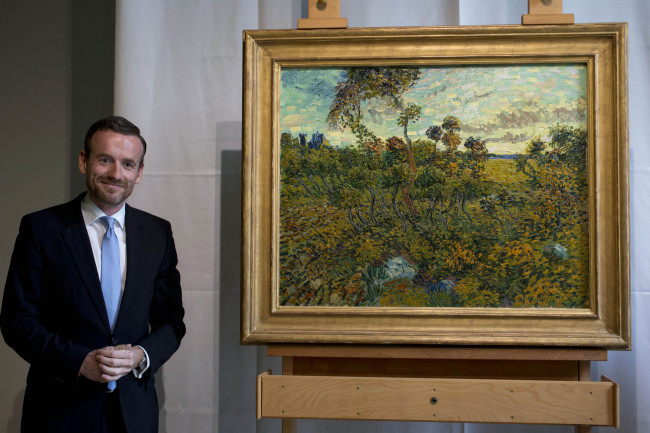AMSTERDAM (AP) ― A painting that sat for six decades in a Norwegian industrialist’s attic after he was told it was a fake Van Gogh was pronounced the real thing Monday, making it the first full-size canvas by the tortured Dutch artist to be discovered since 1928.
Experts at the Van Gogh Museum in Amsterdam authenticated the 1888 landscape “Sunset at Montmajour” with the help of Vincent Van Gogh’s letters, chemical analysis of the pigments and X-rays of the canvas.
Museum director Axel Rueger, at an unveiling ceremony, called the discovery a “once-in-a-lifetime experience.”
 |
Van Gogh Museum director Axel Rueger (left), poses next to “Sunset at Montmajour” after unveiling the painting by Dutch painter Vincent Van Gogh during a press conference at the museum in Amsterdam, Netherlands, Monday. ( AP-Yonhap News) |
“This is a great painting from what many see as the high point of his artistic achievement, his period in Arles, in southern France,” Rueger said. “In the same period, he painted works such as ‘Sunflowers,’ ‘The Yellow House’ and ‘The Bedroom.’”
Museum officials would not identify the owner who brought the artwork to them in 2011 to be authenticated. Van Gogh paintings are among the most valuable in the world, fetching tens of millions of dollars on the rare occasions one is sold at auction.
The artwork will be on display at the museum beginning Sept. 24.
“Sunset at Montmajour” depicts a dry landscape of twisting oak trees, bushes and sky, and was done during the period when Van Gogh was increasingly adopting the thick “impasto” brush strokes that became typical of his work in the final years of his short life.
It can be dated to the exact day it was painted because he described it in a letter to his brother, Theo, and said he had painted it the previous day ― July 4, 1888.
“At sunset I was on a stony heath where very small, twisted oaks grow, in the background a ruin on the hill and wheat fields in the valley,” Van Gogh wrote. “It was romantic. ... The sun was pouring its very yellow rays over the bushes and the ground, absolutely a shower of gold.”
But then Van Gogh confessed that the painting was “well below what I’d wished to do.” Later he sent it to Theo to keep.
Van Gogh struggled with bouts of mental distress throughout his life and died of a self-inflicted gunshot wound in 1890. He sold only one painting during his lifetime.
According to a reconstruction published in The Burlington Magazine by three researchers, the painting was recorded as number 180 in Theo’s collection and given the title “Sun Setting at Arles.” It was sold to French art dealer Maurice Fabre in 1901.
Fabre never recorded selling the work, and the painting disappeared from history until it reappeared in 1970 in the estate of Norwegian industrialist Christian Nicolai Mustad.
The Mustad family said Mustad purchased it in 1908 as a young man in one of his first forays into art collecting, but was soon told by the French ambassador to Sweden that it was a fake. Embarrassed, Mustad banished it to the attic.
After Mustad’s death in 1970, the distinguished art dealer Daniel Wildenstein said he thought the painting was a fake Van Gogh or possibly the work of a lesser-known German painter, and it was sold to a collector. The museum would not say who bought it or whether it had been resold since then.
In 1991, the museum declined to authenticate the painting when whoever owned it at the time brought it to them.
“That may be a painful admission, given that the same museum is now attributing it to Van Gogh, but it is understandable,” since experts had no information about what the painting depicted, the Burlington Magazine article said.
Teio Meedendorp, one of three experts who worked on the project, said his predecessors might also have been confused because the painting was done at a “transitional” moment in Van Gogh’s style.
“From then on, Van Gogh increasingly felt the need to paint with more and more impasto and more and more layers,” he said.
Among other reasons experts had their doubts: The painting was unsigned. Parts of the foreground were not “as well-observed as usual,” the researchers said. And part of the right side of the painting used a different style of brush strokes.
But when the museum took a fresh look at the work in 2011, its experts had the advantage of a new compendium of all Van Gogh’s letters, and they were able to identify for the first time the exact location “Sunset” depicts: Montmajour hill, near Arles. The ruins of Montmajour abbey can be seen in the background.
Van Gogh mentioned the painting in two other letters the same summer.
The number 180 on the back of the canvas was an important clue, and new chemical analysis techniques showed the pigments were identical to others Van Gogh used on his palette at Arles.
Also, an X-ray examination of the canvas showed it was of the same type Van Gogh used on other paintings from the period.
Meedendorp said “Sunset” belongs “to a special group of experimental works that Van Gogh at times esteemed of lesser value than we tend to do nowadays.”
He said it’s not impossible another unknown or lost Van Gogh could be found someday. The artist is believed to have completed more than 800 works. While he destroyed some when he wasn’t satisfied with the results, the whereabouts of others that are mentioned in his letters or early catalogs of his work are unknown.
The Van Gogh Museum houses 140 Van Gogh paintings and receives more than a million visitors a year.






![[Herald Interview] 'Trump will use tariffs as first line of defense for American manufacturing'](http://res.heraldm.com/phpwas/restmb_idxmake.php?idx=644&simg=/content/image/2024/11/26/20241126050017_0.jpg)
![[Exclusive] Hyundai Mobis eyes closer ties with BYD](http://res.heraldm.com/phpwas/restmb_idxmake.php?idx=644&simg=/content/image/2024/11/25/20241125050044_0.jpg)
